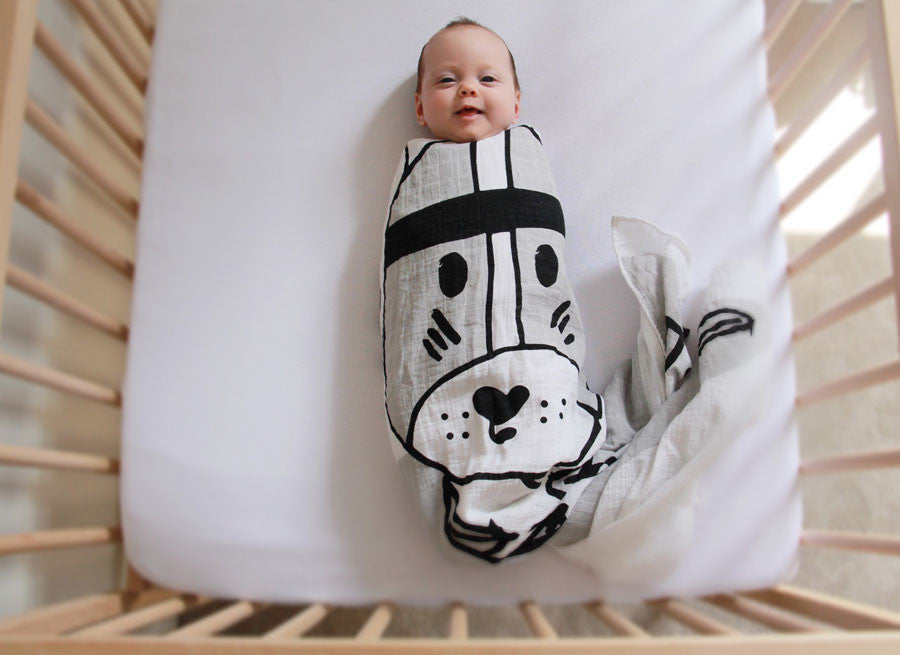The Do's and Don'ts of Baby Swaddle Blankets

Baby on the way? Chances are you're heading headfirst down the rabbit hole that is parenting advice!
Unsurprisingly, one of the most researched topics when it comes to babies is sleep (I mean, who doesn’t love sleep?). And we bet that everyone has an opinion on how you’re going to get your baby to sleep (and have them stay that way).
That advice can be maddeningly confusing. Ultimately, you'll need to do your homework, discuss the issues with your family, and make your own decision.
Wondering about the benefits of baby swaddle blankets? Here's all the information you need!
What Is Swaddling, Exactly?
Swaddling is an age-old practice that has recently regained its popularity as a sleep aid for babies. Wrapping baby in a soft and breathable cotton muslin wrap helps prevent overheating and to feel more comfortable when sleeping on their back. Swaddling also keeps baby’s arms snug to stop a jerking up motion caused by their Moro reflex, which can often startle baby awake.
The Do's and Don'ts of Baby Swaddle Blankets
When done correctly, Swaddling has a number of benefits for both baby and parents. With this in mind, it is important to always put safety first. We have a few tips below on the do’s and don’ts of swaddling to get you started.
DO use a high-quality, organic cotton blanket
Your baby's skin is delicate and sensitive. It is thinner than adults' skin, with fewer natural oils to provide a defence against modern world chemicals.
That means you need to be careful about what you put on it, expose it to, and cover it with. Choosing swaddling blankets made with organic materials and water-based dyes and inks is a wonderful way to treat your child's skin with care.
Non-organic fabric and the materials that make it can contain some pretty scary stuff, and yes, these are even present in normal cotton!
Often, this can include pesticides, bleaches, softeners, dyes, and other chemicals.
Have you ever put on a cheaply made, synthetic item of clothing and just felt itchy? Naturally, you don't want that for your newborn! Instead, give their skin tender care by using natural, organic cotton that is made without pesticides or bleaches.
DO learn the proper method of swaddling
Much like changing a nappy (which you’re going to do only a billion times or so), swaddling is easy once you have done it a few (or a few dozen!) times, but can be daunting for a new parent.
Here are our 5 steps to swaddling:
- Place the baby swaddle blanket on a flat surface, like a bed or changing table, in a diamond shape, with one corner at the top. Fold that corner down about 6 inches.
- Place the baby on top of the blanket, with their head just above the fold.
- Making sure the baby's right arm is held straight at their side, wrap the left side of the fabric over the right arm. Then, tuck it snugly under their body, but beneath the left arm.
- Take the blanket's bottom corner and pull it up over your baby's left shoulder. Tuck in any extra fabric. Be certain that baby can still move their legs at the hips.
- Pull the right corner of the blanket taut and wrap it over the left arm and the rest of their body. Tuck in any excess fabric.
DO know when and how to stop swaddling
Often, parents will put away the baby swaddle blankets when their child is a few weeks old and seems to resist being swaddled, but often this is the period when swaddling is most helpful. Gently hold the baby still to wrap them, and if they still responds well to being snug in their blanket, continue swaddling.
A good rule of thumb is to stop swaddling when your baby starts rolling over, for safety's sake. However, you can also try a semi-swaddle, in which you leave one arm free.
Since your baby is used to being swaddled for many hours out of the day, don't stop all of a sudden. Wean your baby off swaddling by reducing the time they spend wrapped up. Do this gradually over the course of a week or two.
DON'T restrict your child's legs too tightly
It's important to make sure that your little one can move their legs at the hip when swaddled. This is so that their hips can develop properly.
Tight swaddling, especially if the baby's legs are pinned down in a fully straightened position, can lead to hip dysplasia.
Your baby should still be able bend their legs up and out at the hip when swaddled. Remember that the arms and upper torso should be snug, but the legs need some wiggle room.
DON'T swaddle your baby too loosely
On the other hand, a newborn who isn't swaddled tightly enough can squirm their way free of the baby swaddle blanket.
This can pose a suffocation or SIDS risk. It also defeats the purpose of swaddling in the first place. Slide your hand in between the cloth and baby's chest. It should feel as snug as a pair of pants with a comfortable elastic waistband feels on you.
Lastly, don't hesitate to contact us for more information about baby swaddle blankets, to download a free sleep guide, or to read what other mums have to say about swaddling!


